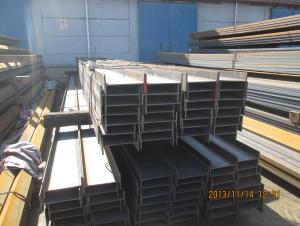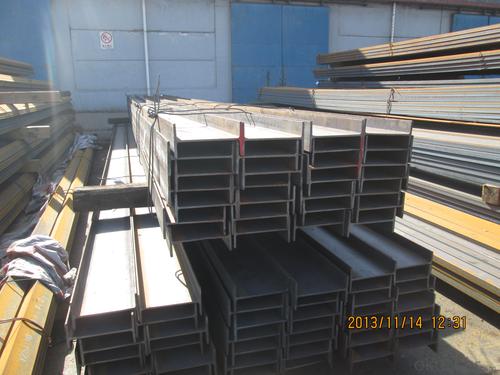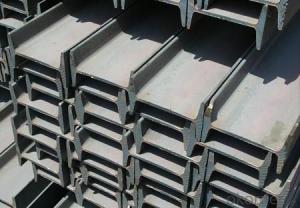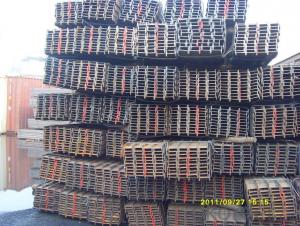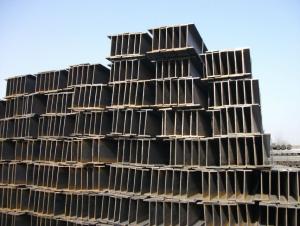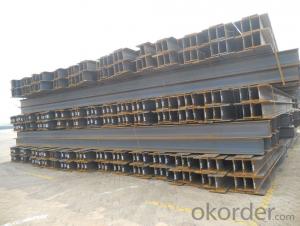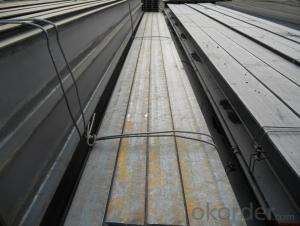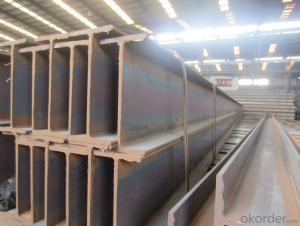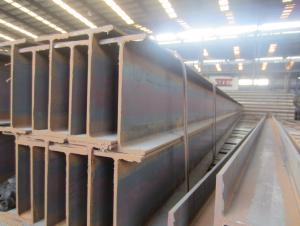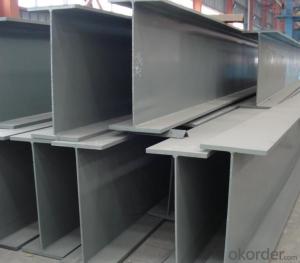Hot Rolled Structual Carbon JIS Standard Steel H-beam Bar
- Loading Port:
- China main port
- Payment Terms:
- TT or LC
- Min Order Qty:
- 25 m.t.
- Supply Capability:
- 1000 m.t./month
OKorder Service Pledge
OKorder Financial Service
You Might Also Like
Product Description:
OKorder is offering high quality Hot Rolled Steel I-Beams at great prices with worldwide shipping. Our supplier is a world-class manufacturer of steel, with our products utilized the world over. OKorder annually supplies products to European, North American and Asian markets. We provide quotations within 24 hours of receiving an inquiry and guarantee competitive prices.
Product Applications:
Commercial building structure ;Pre-engineered buildings; Machinery support structure; Prefabricated structure; Medium scale bridges; Ship-building structure.etc.
Product Advantages:
OKorder's Steel I-Beams are durable, strong, and resist corrosion.
Main Product Features:
· Premium quality
· Prompt delivery & seaworthy packing (30 days after receiving deposit)
· Corrosion resistance
· Can be recycled and reused
· Mill test certification
· Professional Service
· Competitive pricing
Product Specifications:
Manufacture: Hot rolled
Grade: Q195 – 235
Length: 6m – 12m, as per customer request
Packaging: Export packing, nude packing, bundled
H x B
(mm)
| T1 | T2 | JIS Weight
(kg/m)
| GB Weight
(kg/m)
|
100*100 | 6 | 8 | 16.9 | 17.2 |
125*125 | 6.5 | 9 | 23.6 | 23.8 |
150*75 | 5 | 7 | 14 | 14.3 |
148*100 | 6 | 9 | 20.7 | 21.4 |
150*150 | 7 | 10 | 31.1 | 31.9 |
175*90 | 5 | 8 | 18 | 18.2 |
175*175 | 7.5 | 11 | 40.4 | 40.4 |
198*99 | 4.5 | 7 | 17.8 | 18.5 |
200*100 | 5.5 | 8 | 20.9 | 21.7 |
194*150 | 6 | 9 | 29.9 | 31.2 |
200*200 | 8 | 12 | 49.9 | 50.5 |
248*124 | 5 | 8 | 25.1 | 25.8 |
250*125 | 6 | 9 | 29 | 29.7 |
244*175 | 7 | 11 | 43.6 | 44.1 |
250*250 | 9 | 14 | 71.8 | 72.4 |
298*149 | 5.5 | 8 | 32 | 32.6 |
298*201 | 9 | 14 | 65.4 | |
300*150 | 6.5 | 9 | 36.7 | 37.3 |
294*200 | 8 | 12 | 55.8 | 57.3 |
300*300 | 10 | 15 | 93 | 94.5 |
346*174 | 6 | 9 | 41.2 | 41.8 |
350*175 | 7 | 11 | 49.4 | 50 |
340*250 | 9 | 14 | 78.1 | 79.7 |
350*350 | 12 | 19 | 135 | 137 |
400*200 | 8 | 13 | 65.4 | 66 |
390*300 | 10 | 16 | 105 | 107 |
400*400 | 13 | 21 | 172 | 172 |
446*199 | 8 | 12 | 65.1 | 66.7 |
450*200 | 9 | 14 | 77.9 | 79.5 |
440*300 | 11 | 18 | 121 | 124 |
496*199 | 9 | 14 | 77.9 | 79.5 |
500*200 | 10 | 16 | 88.2 | 89.6 |
488*300 | 11 | 18 | 125 | 129 |
596*199 | 10 | 15 | 92.5 | 95.1 |
600*200 | 11 | 17 | 103.4 | 106 |
588*300 | 12 | 20 | 147 | 151 |
700*300 | 13 | 24 | 182 | 185 |
800*300 | 14 | 26 | 207 | 210 |
900*300 | 16 | 28 | 240.1 | 243 |
Packaging & Delivery of Hot Rolled Steel H-beam For Sale
1. Packing: it is nude packed in bundles by steel wire rod
2. Bundle weight: not more than 3.5MT for bulk vessel; less than 3 MT for container load
3. Marks:
Color marking: There will be color marking on both end of the bundle for the cargo delivered by bulk vessel. That makes it easily to distinguish at the destination port.
Tag mark: there will be tag mark tied up on the bundles. The information usually including supplier logo and name, product name, made in China, shipping marks and other information request by the customer.
If loading by container the marking is not needed, but we will prepare it as customer request.
4. Transportation: the goods are delivered by truck from mill to loading port, the maximum quantity can be loaded is around 40MTs by each truck. If the order quantity cannot reach the full truck loaded, the transportation cost per ton will be little higher than full load.
5. Delivered by container or bulk vessel
FAQ:
Q1: Why buy Materials & Equipment from OKorder.com?
A1: All products offered byOKorder.com are carefully selected from China's most reliable manufacturing enterprises. Through its ISO certifications, OKorder.com adheres to the highest standards and a commitment to supply chain safety and customer satisfaction.
Q2: How do we guarantee the quality of our products?
A2: We have established an advanced quality management system which conducts strict quality tests at every step, from raw materials to the final product. At the same time, we provide extensive follow-up service assurances as required.
Q3: How soon can we receive the product after purchase?
A3: Within three days of placing an order, we will begin production. The specific shipping date is dependent upon international and government factors, but is typically 7 to 10 workdays.
Images:
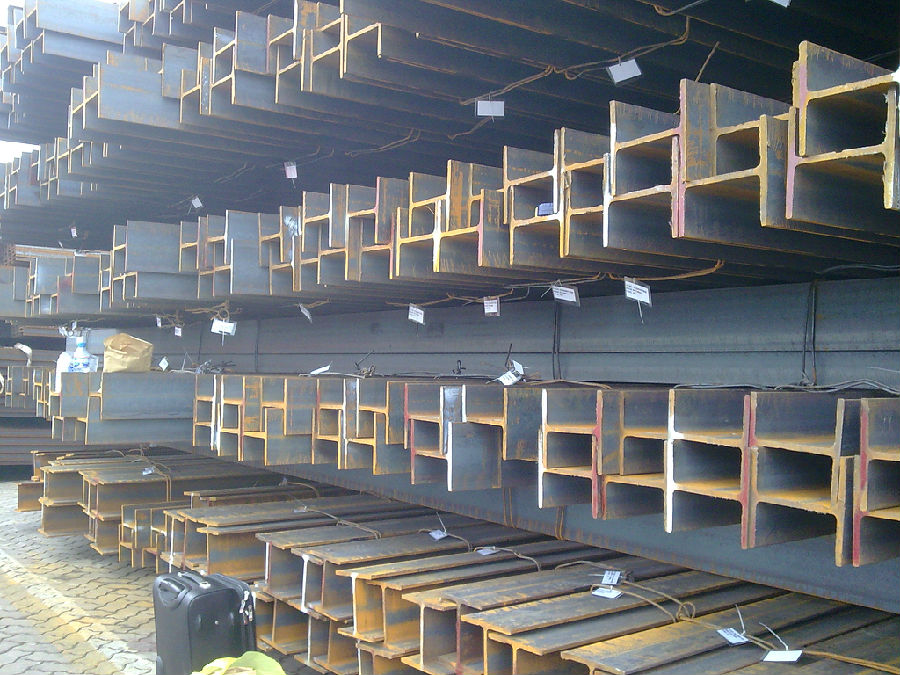
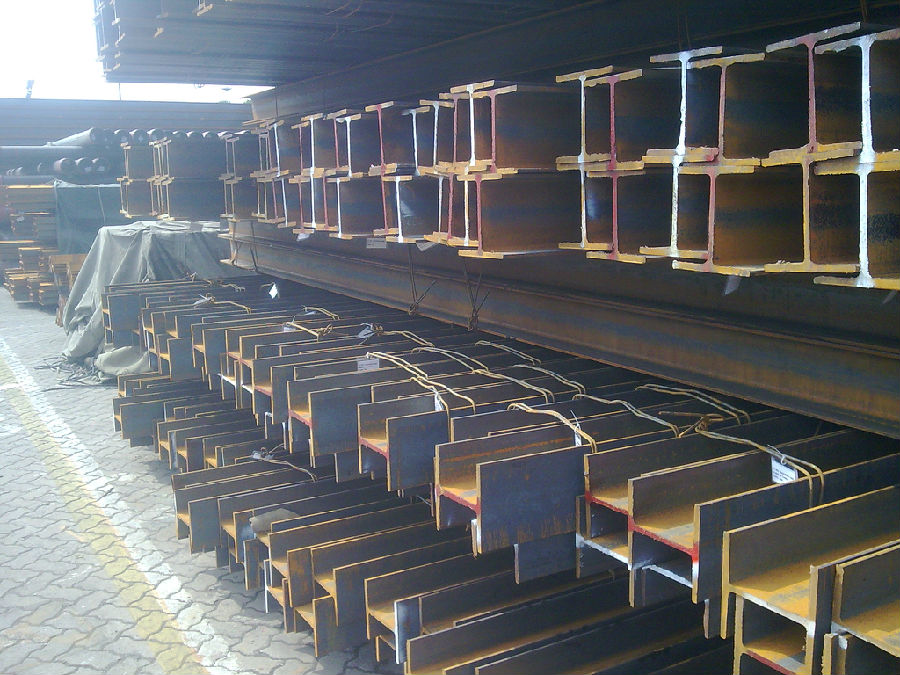
- Q: What are the cost implications of using steel H-beams?
- Various factors can affect the cost implications of using steel H-beams. Firstly, the overall project budget can be significantly impacted by the cost of the beams themselves. Steel is a popular construction material due to its strength and durability, but it tends to be more expensive compared to materials like wood or concrete. The price of steel H-beams is influenced by market demand, supply chain dynamics, and global economic conditions. The size and dimensions of the H-beams also play a role in determining their cost. Larger and heavier beams generally require more steel material and may require specialized handling and transportation, making them more expensive. Moreover, the cost implications of using steel H-beams go beyond just the material. Other factors that need to be considered include fabrication, installation, and maintenance expenses. Fabrication costs involve cutting, welding, and shaping the steel beams to meet the project's specifications. Installation costs include labor, equipment, and any necessary support structures. Ongoing maintenance costs should also be taken into account, as steel requires periodic inspections, painting, and potential repairs for longevity. However, it is important to consider the long-term benefits of using steel H-beams. Their high strength-to-weight ratio and durability make them a reliable choice for structural applications. Steel H-beams have a longer lifespan compared to other materials, reducing the need for frequent replacements or repairs. This can result in long-term cost savings, as the initial investment in steel H-beams can offset the expenses associated with maintenance and replacement in the future. Ultimately, the cost implications of using steel H-beams should be analyzed in the context of specific project requirements, budget constraints, and long-term considerations. Seeking advice from professionals in the construction industry, such as engineers or contractors, can provide a more accurate assessment of the cost implications and assist in making informed decisions.
- Q: How are steel H-beams specified in construction drawings?
- Steel H-beams are specified in construction drawings by providing detailed information about their dimensions, such as the height, width, and thickness of the flanges and web, as well as the overall length. The drawings also include information about the steel grade, tolerances, and any specific requirements for welding or connections. Additionally, the drawings may indicate the location and orientation of the H-beams within the structure, along with any necessary details or notations for installation.
- Q: What are the different load types that steel H-beams can withstand?
- Steel H-beams are designed to withstand various load types, making them highly versatile and suitable for a wide range of applications. The different load types that steel H-beams can withstand include: 1. Uniformly Distributed Load (UDL): Steel H-beams can bear a UDL, which is a load that is spread evenly across the entire length of the beam. This could be the weight of a floor or a roof, for example. 2. Point Load: Steel H-beams are also capable of withstanding point loads, which are concentrated forces applied at a specific point or area on the beam. Examples of point loads include the weight of a heavy equipment or machinery placed directly on the beam. 3. Torsional Load: Steel H-beams have the ability to resist torsional loads, which occur when a twisting force is applied to the beam. This is important in structures that may experience rotational forces, such as bridges or towers subjected to wind or seismic activity. 4. Lateral Load: Steel H-beams can withstand lateral loads, also known as horizontal loads, which are forces acting perpendicular to the axis of the beam. This is crucial in resisting the lateral forces caused by wind or earthquakes. 5. Axial Load: Steel H-beams are designed to resist axial loads, which are forces acting along the axis of the beam. These loads can be compressive (pushing the beam together) or tensile (pulling the beam apart). Axial loads are commonly encountered in columns or vertical members of a structure. 6. Shear Load: Steel H-beams can withstand shear loads, which occur when two forces act in opposite directions parallel to the cross-section of the beam. Shear forces can cause the beam to deform or fail if not properly accounted for in the design. It's important to note that the load capacity of steel H-beams varies depending on factors such as the size and shape of the beam, the type of steel used, and the specific design considerations of the structure. Therefore, it is crucial to consult engineering specifications and calculations to ensure that the H-beams are appropriately selected and applied for the specific load requirements of a given project.
- Q: The difference and use of H type steel steel and steel.
- H steel is a kind of economical section steel with better mechanical performance, especially the cross section, which is named after the English letter "H". Its features are as follows:The flange width, lateral stiffness.The bending capacity, than the beam about 5%-10%.The two flange surfaces parallel to each other makes the connection, convenient manufacture and installation.
- Q: In steel structures, what is the meaning of the "" between the two members of the H steel brace 2L 180*12,10?
- Mainly divided into equilateral angle steel and equilateral angle steel two categories, the unequal angle can be divided into equilateral equilateral thick and unequal thickness two. Angle expressed side and edge thickness size. The current domestic steel specifications for 2 - 20 cm, to length number is the same number. Horn steel often have 2 - 7 different edge thickness. The actual size and the import side angle marked on both sides of the thickness and indicate the relevant standards. The general side of 12.5cm over the large angle, 12.5cm - 5cm for the medium angle, length below 5cm for small angle. The order of a steel export angle to use specification for steel, the carbon steel grades. The corresponding angle in addition to standard number, no specific composition and performance series. Puri steelThe fixed angle delivery length ruler, size two, domestic angle length range is 3 - 9m, 4 - 12M, 4 - 19m, 6 - four 19m range according to the different specifications. The Japanese steel section length range is 6 - 15m. unequal angle height according to length the edge of the equilateral angle steel wide to calculate.
- Q: Are steel H-beams suitable for commercial or industrial buildings?
- Yes, steel H-beams are commonly used in commercial and industrial buildings due to their numerous advantages. Firstly, H-beams provide excellent structural support and can withstand heavy loads, making them ideal for large-scale buildings such as warehouses, factories, and office complexes. Their high strength-to-weight ratio allows for the construction of longer spans and taller structures, maximizing usable space and minimizing the number of columns required. Additionally, steel H-beams are durable and resistant to various environmental factors, such as fire, moisture, and pests. They also offer flexibility in design, allowing for easy modifications and expansions in the future. Moreover, steel is a sustainable and recyclable material, making it an environmentally friendly choice for construction. Overall, steel H-beams are a reliable and cost-effective solution for commercial and industrial buildings, providing both structural integrity and design versatility.
- Q: How do steel H-beams perform in terms of shear resistance?
- Steel H-beams perform exceptionally well in terms of shear resistance due to their structural shape and material strength. The H-beams, with their flanges and web, are designed to distribute and resist shear forces effectively. This configuration allows them to withstand heavy loads and lateral forces, making them highly reliable and suitable for applications where shear resistance is critical, such as in construction and engineering projects.
- Q: What are the different surface coatings available for steel H-beams?
- Various surface coatings are available for steel H-beams, each offering unique benefits and protection. These coatings encompass the following options: 1. Paint: The most common and cost-effective coating for steel H-beams is paint. It creates a protective layer that prevents corrosion and can be customized with different colors or finishes. Periodic maintenance and touch-ups are necessary to maintain its effectiveness. 2. Galvanizing: A prevalent coating for steel H-beams is galvanizing, which involves applying a layer of zinc through hot-dip galvanization. This coating provides excellent corrosion resistance and is particularly suitable for outdoor applications or environments with high humidity or exposure to chemicals. 3. Powder Coating: Powder coating is an environmentally friendly and durable option for steel H-beams. It entails applying a dry powder that is then heated and fused into a smooth and protective layer. Powder coatings resist corrosion, chemicals, and UV rays, making them suitable for indoor and outdoor use. 4. Epoxy Coating: Epoxy coatings are commonly used in industrial or marine settings where superior chemical resistance is required. These coatings are applied in multiple layers and offer excellent protection against corrosion, abrasion, and impact. 5. Chrome Plating: Chrome plating involves depositing a thin layer of chromium onto the surface of steel H-beams. This coating provides exceptional corrosion resistance and a reflective, visually appealing finish. It is often used for decorative or high-end applications. 6. Thermal Spray Coatings: Thermal spray coatings encompass applying a molten material onto the steel H-beam surface using a specialized spraying process. The materials used can include zinc, aluminum, or ceramics, depending on the desired properties. Thermal spray coatings offer excellent corrosion resistance, thermal insulation, or wear resistance, depending on the material applied. When selecting a surface coating for steel H-beams, it is important to consider the specific application and environmental conditions. Consulting with a coatings specialist or manufacturer can help determine the most appropriate coating based on performance requirements, aesthetics, and budget.
- Q: Can steel H-beams be used for composite structures?
- Yes, steel H-beams can be used for composite structures. Steel H-beams are commonly used as primary structural members in composite structures where they work in conjunction with other materials, such as concrete or timber, to form a composite system. This combination of materials enhances the overall structural performance, providing increased strength and load-bearing capacity.
- Q: How do steel H-beams compare to timber beams in terms of durability?
- Steel H-beams are generally more durable than timber beams. Steel has a higher strength-to-weight ratio and is resistant to rot, insects, and fire. Steel beams can withstand heavy loads and have a longer lifespan compared to timber beams, which can be prone to decay, warping, and damage from pests.
Send your message to us
Hot Rolled Structual Carbon JIS Standard Steel H-beam Bar
- Loading Port:
- China main port
- Payment Terms:
- TT or LC
- Min Order Qty:
- 25 m.t.
- Supply Capability:
- 1000 m.t./month
OKorder Service Pledge
OKorder Financial Service
Similar products
Hot products
Hot Searches
Related keywords
